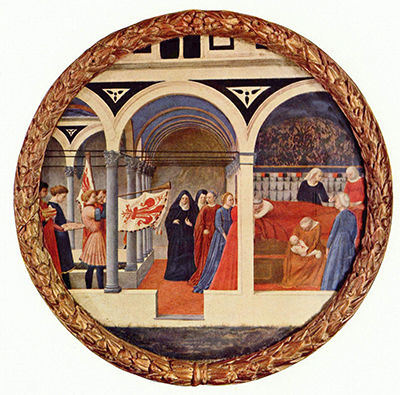The painting Birth Tray is also known as Berlin Tondo, conceived during 1427-1427 by the Italian renaissance artist Masaccio.
The medium of the painting is a tempura on wood that was created in order to be displayed on the alter piece of a chapel.
While the birth of Jesus was popularity depicted throughout renaissance paintings, illustrations of the birth of children were not showcased within artists work. The fruitful nature is not a prominent illustration showcased as it did not hold a mystical feel to the work, as many were aware of the difficulties and hardship that occurred during birth.
The painting illustrates the gathering of individuals as they witness the birth of a child. The nativity scene is a prominent illustration of the natural occurrence of birth as displayed within the brilliant artwork.
The viewer is able to witness a large red bed located on the right side of the painting as a mother is seated near the bottom holding the child within her arms. While the artwork does not go into an array of detail in order to depict these images, minor details are showcased illuminating the female figure. The motherly instinct imbedded within a woman is highlighted as it is this figure who holds her new-born child within her arms.
The immense difficulties that occurred during childbirth during the early centuries were followed with celebrations appreciating the new-born child. As evident through Birth Tray, a large celebration occurs welcoming the baby held in the motherÕs arms. Arrays of individuals are showcased in a luxurious setting up raising the strong social status of the couple.
Young woman fill the right side of the canvas as they gather to witness the new child, accompanied by two nuns dressed in black entering the scene. The women are dressed on long colourful gowns, drenched in blue and red shades. These pigmented textiles add to the colour of the painting, a signature style of Masaccio.
The renaissance artist did not shy away from the use of colour as he used it to up rise warm emotions of happiness and prosperity. To the left of the painting, male figures gather together celebrating the arrival of the child. A tall man dressed in a classic guards outfit blows a horn that holds a flag attached to it. Based on the luxurious setting of the artwork, the celebration seems to be held within a castle as friends of the rulers come to manifest their support and excitement.
The artist had interestingly painted the artwork horizontally as he attempts to flatten the artwork but still add elements of depth through the large volumes that fill the room. The columns add a brilliant architecture to the room as it is structured around the room. Shades of white and black fill the arches as real blues are swept across.
The brilliant set up of the room breaks the events occurring within into three sections. The right side illustrates the woman and her child as her female companions swarm in to congratulate her. The middle section illustrates young woman in colourful dresses entering, alongside calm nuns. The left side of the painting illustrates men in Leominster costumes celebrating the arrival of the child.




